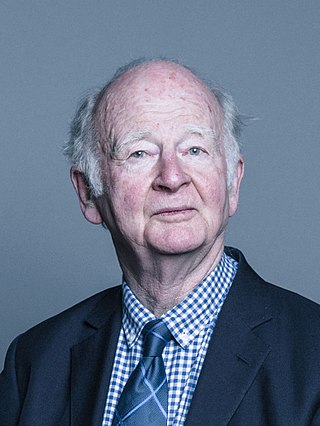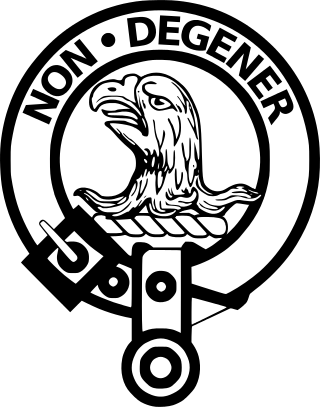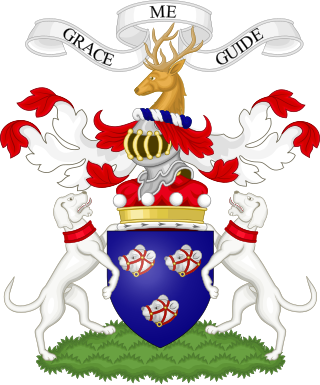
Earl of Glasgow is a title in the Peerage of Scotland. It was created in 1703 for David Boyle, Lord Boyle.

Fairlie is a village in North Ayrshire, Scotland.

David Boyle, 7th Earl of Glasgow,, was a British naval commander and colonial governor. He served as Governor of New Zealand between 1892 and 1897.

David Boyle, 1st Earl of Glasgow was a Scottish politician and peer. He was the last Treasurer-depute before the Union with England.

Clan Carmichael is a Scottish clan and is also considered a sept of the Clan Douglas, Clan MacDougall, Stewart of Appin, and Stewart of Galloway.

Clan Cathcart is a Lowland Scottish clan.

Clan Colville is a Lowland Scottish clan.

Clan Lennox is a Lowland Scottish clan. The clan chiefs were the original Earls of Lennox, although this title went via an heiress to other noble families in the fifteenth and sixteenth centuries. The chiefship of the clan then went to the Lennox of Woodehead branch.

Clan Lindsay is a Scottish clan of the Scottish Lowlands.

Clan Stewart is a Scottish Highland and Lowland clan. The clan is recognised by Court of the Lord Lyon; however, it does not have a clan chief recognised by the Lord Lyon King of Arms. Because the clan has no chief it can be considered an armigerous clan; however, the Earls of Galloway are now considered to be the principal branch of this clan, and the crest and motto of The Earls of Galloway's arms are used in the Clan Stewart crest badge. The Court of the Lord Lyon recognises two other Stewart/Stuart clans, Clan Stuart of Bute and Clan Stewart of Appin. Stuart of Bute is the only one of the three clans at present which has a recognised chief.

Patrick Robin Archibald Boyle, 10th Earl of Glasgow,, is a Scottish peer, politician and the current chief of Clan Boyle. The family seat is Kelburn Castle in Ayrshire. He currently sits as a Liberal Democrat peer in the House of Lords.

Clan Wedderburn is a Lowland Scottish clan.

Clan Stuart of Bute is a Highland Scottish Clan and is a branch of the larger Clan Stewart.

Clan Forbes is a Highland Scottish clan from Aberdeenshire, Scotland.
Captain James Carr-Boyle, 5th Earl of Glasgow, styled Viscount Kelburn from 1818 until 1843, was a British naval commander and politician.
George Ross, 11th Lord Ross of Halkhead, was a Scottish nobleman and soldier.
George Ross, 13th Lord Ross of Halkhead, was a Scottish nobleman.
John Boyle, 2nd Earl of Glasgow was a Scottish nobleman.

John Boyle, 3rd Earl of Glasgow was a Scottish nobleman.
Patrick Boyle, Lord Shewalton (1690–1761) was a Scottish judge who served as a Senator of the College of Justice.
















